

Caleb Mullins
Design. More formally design has been defined as follows.
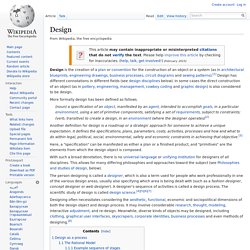
Another definition for design is a roadmap or a strategic approach for someone to achieve a unique expectation. Industrial design. An iPod, an industrially designed product.
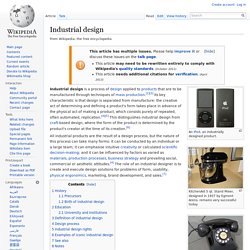
KitchenAid 5 qt. Stand Mixer, designed in 1937 by Egmont Arens, remains very successful today Western Electric Model 302 telephone, found throughout the United States from 1937 until the introduction of touch-tone dialing.[1] Calculator Olivetti Divisumma 24 designed in 1956 by Marcello Nizzoli All industrial products are the result of a design process, but the nature of this process can take many forms: it can be conducted by an individual or a large team; it can emphasise intuitive creativity or calculated scientific decision-making; and it can be influenced by factors as varied as materials, production processes, business strategy and prevailing social, commercial or aesthetic attitudes. History[edit] Precursors[edit] The division of labour that underlies the practice of industrial design did have precedents in the pre-industrial era.
Product design. Product design is the process of creating a new product to be sold by a business to its customers.[1] A very broad concept, it is essentially the efficient and effective generation and development of ideas through a process that leads to new products.
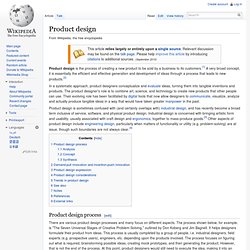
In a systematic approach, product designers conceptualize and evaluate ideas, turning them into tangible inventions and products. The product designer's role is to combine art, science, and technology to create new products that other people can use. Their evolving role has been facilitated by digital tools that now allow designers to communicate, visualize, analyze and actually produce tangible ideas in a way that would have taken greater manpower in the past.
Usability. Usability is the ease of use and learnability of a human-made object.
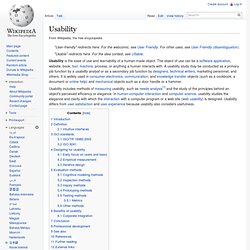
The object of use can be a software application, website, book, tool, machine, process, or anything a human interacts with. A usability study may be conducted as a primary job function by a usability analyst or as a secondary job function by designers, technical writers, marketing personnel, and others. It is widely used in consumer electronics, communication, and knowledge transfer objects (such as a cookbook, a document or online help) and mechanical objects such as a door handle or a hammer. Usability includes methods of measuring usability, such as needs analysis[1] and the study of the principles behind an object's perceived efficiency or elegance. In human-computer interaction and computer science, usability studies the elegance and clarity with which the interaction with a computer program or a web site (web usability) is designed.
Introduction[edit] Definition[edit] Usability is a non-functional requirement. Ergonomics. Human factors and ergonomics (HF&E), also known as comfort design, functional design, and user-friendly systems,[1] is the practice of designing products, systems or processes to take proper account of the interaction between them and the people who use them.
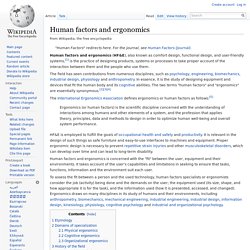
The field has seen contributions from numerous disciplines, such as psychology, engineering, biomechanics, industrial design, physiology and anthropometry. In essence, it is the study of designing equipment and devices that fit the human body and its cognitive abilities. The two terms "human factors" and "ergonomics" are essentially synonymous.[2][3][4] The International Ergonomics Association defines ergonomics or human factors as follows:[5] HF&E is employed to fulfill the goals of occupational health and safety and productivity.
Human factors and ergonomics is concerned with the "fit" between the user, equipment and their environments. Etymology[edit] Domains of specialization[edit] New terms are being generated all the time. Books. Aesthetics. "Aesthetician" redirects here.

For a cosmetologist who specializes in the study of skin care, see Esthetician. More specific aesthetic theory, often with practical implications, relating to a particular branch of the arts is divided into areas of aesthetics such as art theory, literary theory, film theory and music theory. An example from art theory is aesthetic theory as a set of principles underlying the work of a particular artist or artistic movement: such as the Cubist aesthetic.[6] Etymology[edit] The word aesthetic is derived from the Greek αἰσθητικός (aisthetikos, meaning "esthetic, sensitive, sentient"), which in turn was derived from αἰσθάνομαι (aisthanomai, meaning "I perceive, feel, sense").[7] The term "aesthetics" was appropriated and coined with new meaning in the German form Æsthetik (modern spelling Ästhetik) by Alexander Baumgarten in 1735.
Aesthetics and the philosophy of art[edit] Aesthetics is for the artist as Ornithology is for the birds.— Barnett Newman[8][9] Graphic design. Typography. In philately "typography", especially in the case of 19th century stamps, refers to letterpress printing.
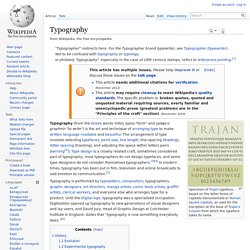
Typography is performed by typesetters, compositors, typographers, graphic designers, art directors, manga artists, comic book artists, graffiti artists, clerical workers, and everyone else who arranges type for a product. Until the Digital Age, typography was a specialized occupation. Digitization opened up typography to new generations of visual designers and lay users, and David Jury, Head of Graphic Design at Colchester Institute in England, states that “typography is now something everybody does.”[6] §History[edit] Printing press, 16th century in Germany The essential criterion of type identity was met by medieval print artifacts such as the Latin Pruefening Abbey inscription of 1119 that was created by the same technique as the Phaistos disc.
Modern movable type, along with the mechanical printing press, is most often attributed to the goldsmith Johannes Gutenberg. §Scope[edit] Engineering. The American Engineers' Council for Professional Development (ECPD, the predecessor of ABET)[1] has defined "engineering" as:

Economics. For a topical guide to this subject, see Outline of economics.
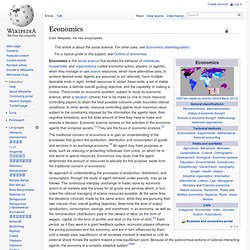
Economics is the social science that studies the behavior of individuals, households, and organizations (called economic actors, players, or agents), when they manage or use scarce resources, which have alternative uses, to achieve desired ends. Agents are assumed to act rationally, have multiple desirable ends in sight, limited resources to obtain these ends, a set of stable preferences, a definite overall guiding objective, and the capability of making a choice. There exists an economic problem, subject to study by economic science, when a decision (choice) has to be made by one or more resource-controlling players to attain the best possible outcome under bounded rational conditions. In other words, resource-controlling agents must maximize value subject to the constraints imposed by the information the agents have, their cognitive limitations, and the finite amount of time they have to make and execute a decision. J.